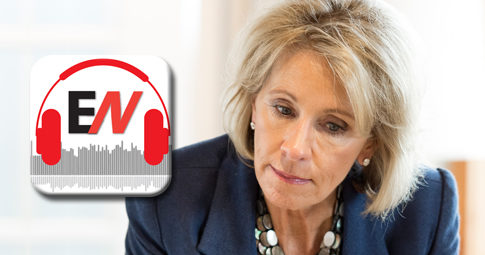An admission: This issue of Education Next differs markedly from what our editorial team had envisioned in the early fall. The events of November 8, 2016, took many by surprise, including us.
Notably absent here is a profile of Hillary Clinton’s record as an advocate for children and analysis of what we could have expected on education policy from the nation’s first female president. We had not commissioned a parallel piece on Donald Trump.
 Projecting the future under Secretary Clinton, who had taken nuanced positions on key issues such as charter schools and testing over the course of her long political career, was hardly straightforward. But that task paled in comparison to the challenge of anticipating what’s next under President Trump, who promises big changes to education but faces uncertain legislative backing for his top priority: expanding school choice.
Projecting the future under Secretary Clinton, who had taken nuanced positions on key issues such as charter schools and testing over the course of her long political career, was hardly straightforward. But that task paled in comparison to the challenge of anticipating what’s next under President Trump, who promises big changes to education but faces uncertain legislative backing for his top priority: expanding school choice.
By tapping philanthropist and school-choice advocate Betsy DeVos for education secretary, Trump has signaled that he intends to make good on his pledge to use $20 billion in federal funds to give students from poor families more options. That proposal may face tough sledding in Congress, however. Legislators there recently rejected proposals that would merely have allowed states to use federal aid for disadvantaged students to help them attend private schools, and deficit hawks are likely to resist what would amount to a 40 percent increase in congressional spending on K–12 education.
The president and his team may instead seek to amend the tax code to encourage donations to organizations that grant scholarships to low-income students, an approach 16 states use as an alternative to school voucher programs. Congress can make such changes to tax policy through “reconciliation,” a procedure that avoids up-or-down votes on each proposal and the threat of a Democratic filibuster in the Senate.
In weighing their options, members of the new administration would do well to read Chad Aldeman’s reflections on their predecessors’ efforts to overhaul how American teachers are evaluated, an agenda the Obama team pursued through a series of incentives for states devised within the executive branch (see “The Teacher Evaluation Revamp, in Hindsight,” features). Aldeman, who was a policy adviser at the Department of Education under President Obama, credits his former colleagues for tackling a pressing problem and stimulating positive changes in some locales.
But he argues that the Obama administration erred by adopting a narrow definition of reform and by seeking to implement that definition universally, even where local support was lacking. Aiming to spread its ideas as far and fast as possible, the education department eventually required all states seeking much-needed waivers from No Child Left Behind to adopt test-based evaluation systems. The result was lackluster implementation, backlash from educators, and a broad perception that the policies had failed.
A comparably ambitious federal school-choice agenda would face similar challenges. Even if the Trump administration gets its $20 billion, it will need to rely on states and school districts to implement policies that give families new options. Three decades of experimentation with school choice demonstrate that making it work requires careful attention to such tasks as ensuring that parents have good information about school quality and suitable transportation—responsibilities that skeptical local bureaucrats may dodge. Nor are there one-size-fits-all strategies that will work everywhere. School vouchers, for example, are unlikely to solve the problems facing students in the vast swaths of rural America where voters went heavily for Donald Trump.
The best solution may be to offer federal support for programs that the states themselves design, advancing the cause of school choice while respecting the principle of local control that Trump has also championed. Beyond that, the administration can use the bully pulpit to promote state-level reform. It can offer guidance on how states can take advantage of certain features of the Every Student Succeeds Act to give students new options, such as the funding states may set aside to provide “direct student services” in struggling districts. It can work with Congress to offer additional grants for charter school start-ups and perhaps create a similar funding program to encourage innovation in the private sector. Above all, it can ensure that federal regulations don’t interfere with local efforts to experiment with new school-governance arrangements.
Such efforts may feel like small ball to a president for whom “huge” denotes high praise, but over the long haul they are likely to accomplish more than any attempts at sweeping measures. And after two decades of presidential activism in K–12 education, seeing an administration respect the limits on federal capacity would be a welcome surprise.
— Martin R. West
This article appeared in the Spring 2017 issue of Education Next. Suggested citation format:
West, M.R. (2017). Under New Administration, Small Measures Could Foster Big Change. Education Next, 17(2), 5.




